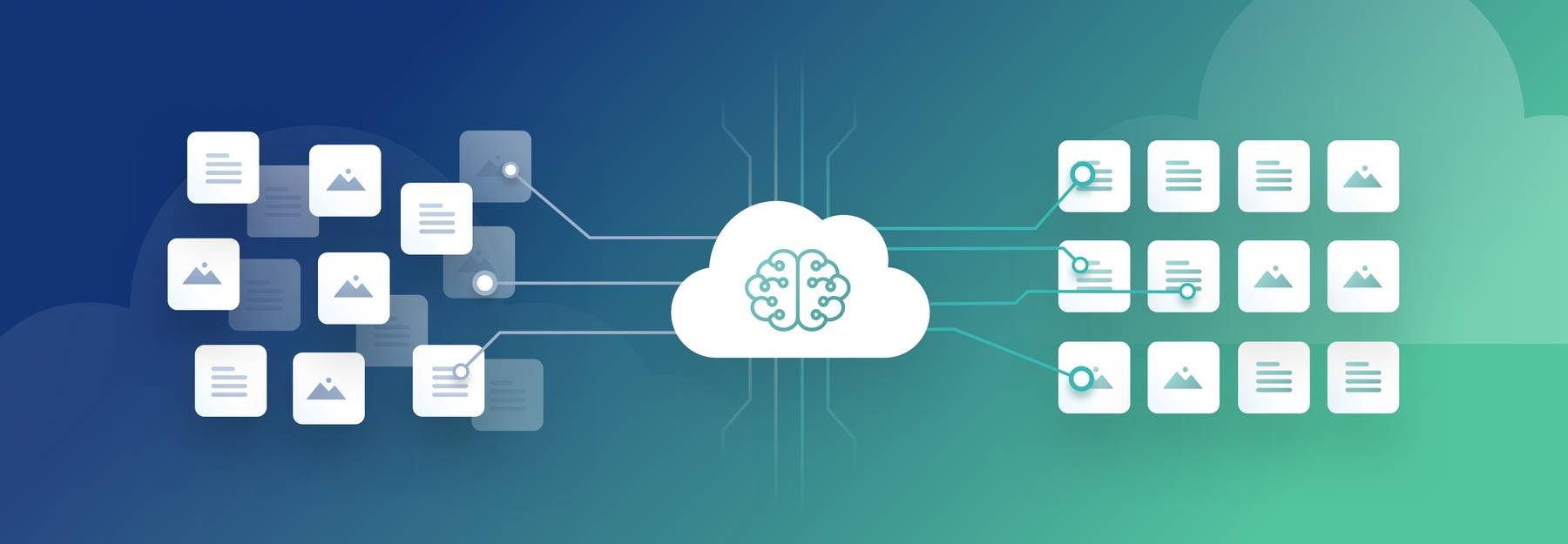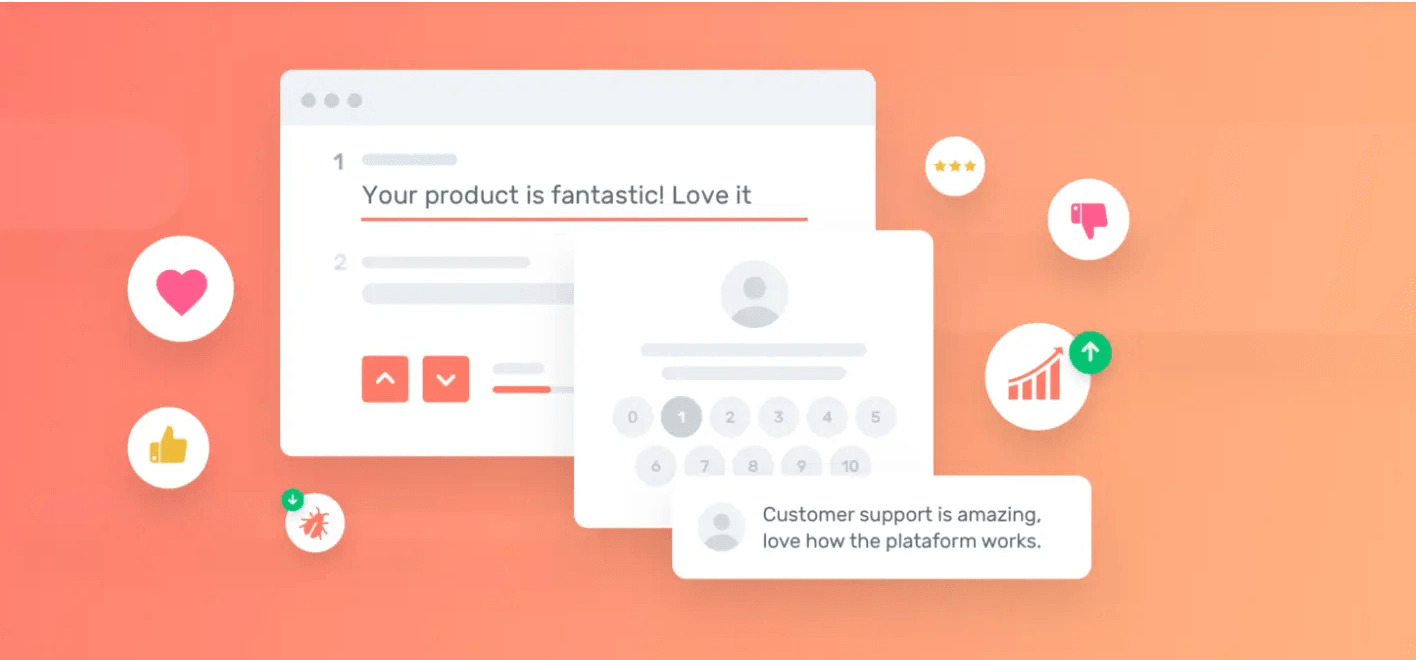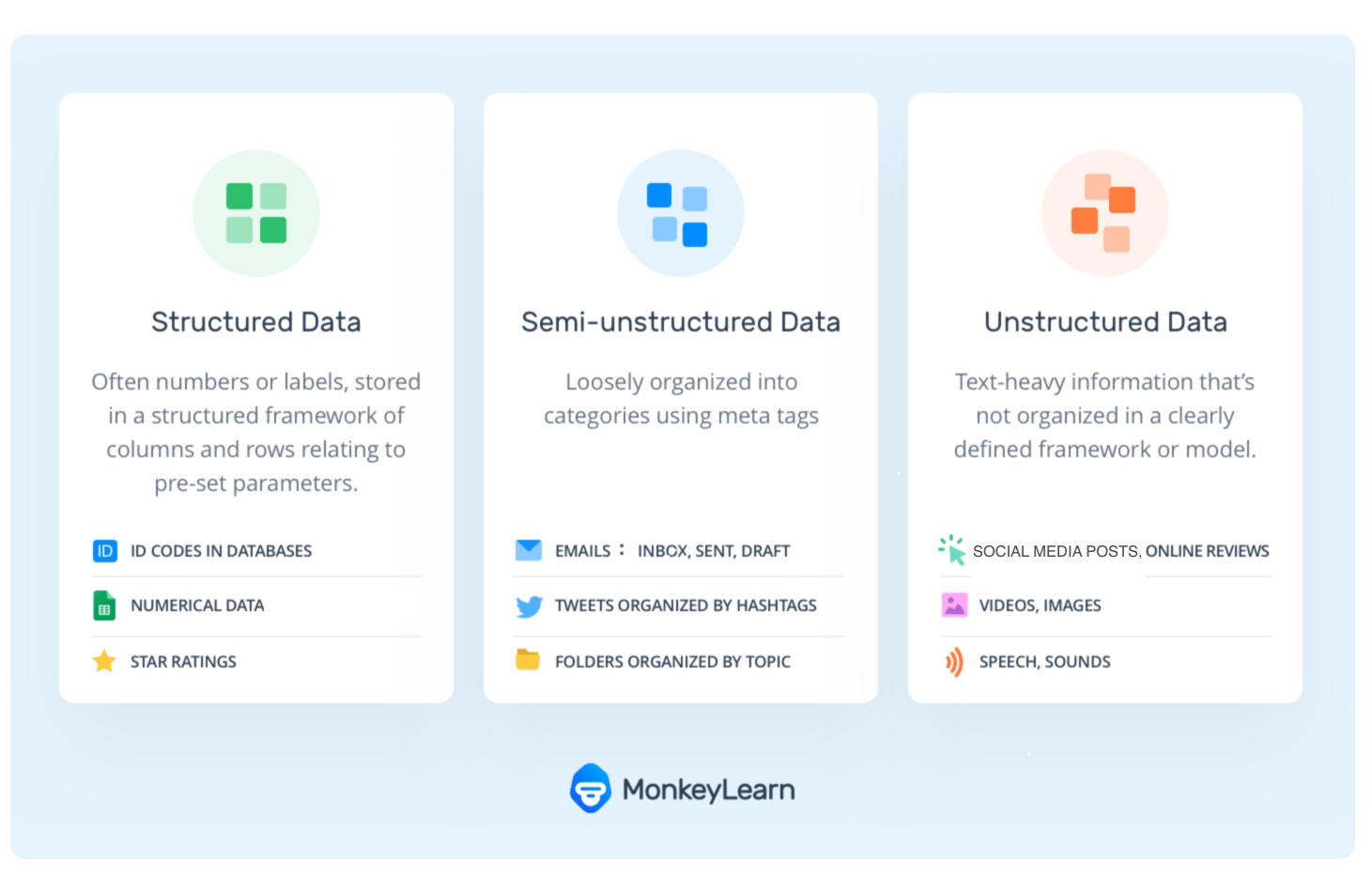A Guide to Unstructured Data: What Is It & How to Analyze It

Until recently, it was a lot harder to analyze unstructured data, due to the hundreds of human hours required to wade through it by hand.
Fortunately, advancements in AI tools now make it possible for machines to sort unstructured data automatically, saving you huge amounts of time, and allowing teams to make data-based decisions based on powerful customer insights.
Get insights from unstructured data
By the end of this guide, you’ll have a solid understanding of what unstructured data is – and you’ll discover how easy it is to perform unstructured data analysis with no-code AI tools like MonkeyLearn.
- What Is Unstructured Data?
- Structured Data Vs Unstructured Data
- Unstructured Data Types & Examples
- Why Is Unstructured Data Important?
- How to Analyze Unstructured Data
- Unstructured Data Analysis Tools
So let’s jump to it.
What Is Unstructured Data?

Unstructured data are datasets that have not been structured in a predefined manner. Unstructured data is typically textual, like open-ended survey responses and social media conversations, but can also be non-textual, like images, video, and audio.
Unstructured information is growing quickly due to increased use of digital applications and services. Some estimates say that 80-90% of company data is unstructured, and it continues to grow at an alarming rate per year.
While structured data is important, unstructured data is even more valuable to businesses if analyzed correctly. It can provide a wealth of insights that statistics and numbers just can’t explain.
Structured Data Vs. Unstructured Data: What's The Difference?
Structured, unstructured and semi-structured data all fall under the umbrella of ‘big data’.
While all three types of data can offer incredible insights, it’s important to know which data type to collect and when, and which one to analyze for the insights you’re hoping to gain.
Let’s start with unstructured data.
Although it contains figures, statistics, and facts, unstructured data is usually text-heavy or configured in a way that’s difficult to analyze.
Social media posts, for example, might contain opinions, topics that are being discussed, and feature recommendations. But this information is difficult to process in bulk. First, specific bits of information must be extracted and categorized, then analyzed to gain usable insights.
Structured data, on the other hand, is often numerical and easy to analyze. It’s organized in a pre-defined structured format, such as Excel and Google Sheets, where data is added to standardized columns and rows relating to pre-set parameters. The framework of structured data models is designed for easy data entry, search, comparison, and extraction.
There is also semi-structured data, which is also text-heavy data but loosely organized into categories or “meta tags.” This information can be easily broken into its individual groups, but the data within these groups is itself unstructured.
Email is a good example of this: you can search your email by Inbox, Sent, and Drafts, but the email text within each category has no pre-set structure.
Later, we’ll explain how you can get more from your unstructured and semi-structured data with SaaS unstructured data analysis solutions like MonkeyLearn. First, though, let’s take a look at different unstructured data types.
Unstructured Data Types & Examples

Examples of unstructured data include legal documents, audio, chats, video, images, text on a web page, and much more. Discover some of the most common unstructured data examples below:
Examples of unstructured data are:
- Business Documents
- Emails
- Social Media
- Customer Feedback
- Webpages
- Open Ended Survey Responses
- Images, Audio, and Video
Business Documents
Written business reports, legal documents, and presentations are often printed on paper, in PDFs, or even hand-written, and some may contain spreadsheets, images, or XML files. Although text files may be organized in a common format, data isn’t structured in a way that can be analyzed without advanced AI technology.
These documents contain huge amounts of unstructured data that often goes unexploited, as it’s considered too time-consuming to analyze. Fortunately, by using text analysis techniques, companies can now gather valuable information from these documents about customers, employees, and use them for competitive research.
Emails
We send dozens of emails daily, which translates into huge amounts of unstructured data. Although emails are semi-structured by categories, like in this example below, the data within each email is unstructured.

Text analysis software can scan through thousands of emails in seconds to extract customer information, organize by category and route to the proper department, track customer service quality, and more.
You can even find out what kind of language works best for customer communication and easily analyze to find out major customer pain points in just a few minutes. For example, you might discover particular topics that are mentioned most frequently in a negative way.
Social Media
Social media data is similar to emails, in that some of it is organized. Hashtags, for example, help users search for topics that they’re interested in. But the messages containing these hashtags are unstructured.

Social media data mass-grows by the second into a huge, nebulous, real-time archive of ideas, opinions, and statistics. When social media users mention brands and products, it can turn into useful data that can be mined for opinions.
You might even follow trends within your field in real time and regularly. Once you set the parameters and train text analysis models for your business, you can gain dozens of useful insights from social media. And it’s all done automatically with machine learning.
Customer Feedback
Customer feedback can come in many forms: online reviews, surveys, phone calls, and unsolicited social media posts. When it’s possible to gather and analyze all of this information together, you can get a fully-balanced view into the thoughts of your customers.
Follow your customers’ major concerns daily, implement changes, and track the results with tools like sentiment analysis and word clouds. You’ll save time and increase accuracy with text analysis software – no more guesswork or semi-informed decision making.
By performing customer feedback analysis, you’ll have hard data on the voice of the customer and an overview of your area of expertise.
Webpages
The vast internet creates unstructured data at breakneck speed. Webpages can include text, images, audio, video, all manner of content. And while the structure of web pages is written in HTML code, this doesn’t actually explain the content of the pages.
It can be useful to mine, extract, and organize this data to find information about customers, competitors, and overall public sentiment. Also, as web pages are constantly changing, machine learning software allows you to constantly track them and compare throughout time.
Open-Ended Survey Responses
While some surveys are designed to be easily analyzed with multiple-choice questions, there are usually more insights to be gained from open-ended questionnaires. Because responders answer in their own words, the text or recordings produced need to be broken down into usable data before it can be properly analyzed.
Performing survey analysis on open-ended responses offers more nuance and may even include new ideas and recommendations from customers.
Once the unstructured responses have been gathered, they can be organized and analyzed with business intelligence tools that classify, analyze and visualize data. Discover 6 effective ways to analyze open-ended responses in NPS surveys.

Images, Audio, and Video
Although multimedia files may be tagged with titles or subjects and saved in databases as MP3, JPG, PNG, GIF, etc., they are still unstructured because we don’t know what the image, audio, or video represents.
Speech-to-text technology like Gong, however, can be used to convert audio files into text, which can then be analyzed by natural language processing software. And image and video analysis has made great advancements with facial and subject recognition software.
Importance of Unstructured Data
The majority of data created today is unstructured (documents, social media, emails), and often an untapped resource. When managed in the right way, unstructured data can deliver countless insights that help you make informed, data-driven decisions.
Machine learning technology allows you to automatically manage and analyze unstructured data quickly and accurately. Through technological advancements, like natural language processing (NLP), machines can now read text just like a human would. That means you can eliminate repetitive tasks like manually tagging and routing tickets, or sifting through social media posts.
Instead, AI technology can automatically learn how to extract keywords, names, phone numbers, and locations, understand opinions and intent, and recognize topics that are important to your business. Once all your unstructured data has been organized, you’ll gain granular insights that will help you make informed business decisions.
Benefits of Unstructured Data Analytics Tools
Unstructured data analytics tools are specifically designed to gather and analyze unstructured information. Using unstructured data analytics tools, equipped with machine learning and natural language processing capabilities, you can automatically scan through emails or customer service tickets and gain valuable insights.
Manually analyzing unstructured data is extremely time-consuming, and humans bore easily, which can skew the results. Using data analytics tools like MonkeyLearn Studio, on the other hand, is 1200x faster than a person, consistently accurate, completely scalable, and works constantly, in real time.
The importance of unstructured data analysis for businesses:
Improve the Customer Experience
Text analytics software can monitor emails, live chats, and social media posts, and customer support tickets in real time.
Automatically route tickets to the correct department in seconds, so your customers aren’t left waiting. You can even connect tools like MonkeyLearn directly to your helpdesks, so you can streamline the process of sorting your unstructured data by department.

AI tools can further analyze customer support information to be sure your customers are getting the support they need without having to monitor employee responses manually.
Discover Gaps in the Market & Innovate
Follow trends in the market and anticipate changes before your competition. Use AI software to monitor news reports, social media, and online reviews of your competitors, and compare the results to your own data.
Analyze and regularly track your competitor’s online content to find out what works for them. You’ll get a solid understanding of your own strengths and weaknesses and how they compare to your competitors’. You might also discover new ideas that you may not have considered.
Unstructured data analysis tools like word clouds can also quickly read through text to give you an easy-to-understand view of commonly used words and phrases within your dataset. The below is a word cloud made from reviews of the messaging app, WhatsApp:
Word clouds are visualizations of the most used words in a text – the larger words are, the more frequently they are used. They can be great to find the most important words to focus on and compare to your competition. However, you’ll need more advanced unstructured data analytics tools to gain more granular insights.
Listen to Your Customers
Machine learning software can automatically read through open-ended customer surveys and emails. But beyond this you can track even unsolicited feedback from social media, online reviews, blogs, and more.
Track your company name; train machine learning software to find keywords specific to your industry; and perform sentiment analysis to automatically detect the opinion of the writer, as in the below:

Analyze thousands of social media posts in minutes or monitor your brand constantly, in real time. Search for company mentions on Twitter, Facebook, and more. Keep your finger on the pulse of your customers and the public at large. Find out what users love about your business and what you might need to work on.
You can track new product releases and marketing campaigns and compare them to find out what works best to draw in new customers and keep the ones you already have.
Take aspect-based sentiment analysis, for example. It’s a text analysis technique that organizes text into aspects (features or components of a product or service), then assigns sentiment (positive, negative, neutral) to each.
The below is an example of how aspect-based sentiment analysis works on reviews of Drift software:

How to Analyze Unstructured Data

In the past, the analysis that could be done on unstructured data was relatively insignificant and would be stored in document management systems that kept track of version histories, metadata, and indexing. But data analysis of individual documents was essentially manual.
Now there are a number of data analysis tools with highly advanced algorithms that are designed specifically to break down unstructured (usually text) data and store the results. Unstructured data analysis tools combine machine learning algorithms and natural language processing to create deep learning software programs that can be trained for specific industries and needs.
Before we take a look at these tools, let’s quickly go over how to properly manage unstructured data, so that it’s ready for you to analyze:
1. Choose the End Goal
Make sure you define a clear set of measurable goals. What insights do you want to obtain from your data? Do you want to understand how customers feel about a particular topic? Knowing this will help you identify what type of unstructured data you need to collect.
2. Collect Relevant Data
Data is everywhere, but maybe you just want to focus on data from one channel, like social media, online reviews, or surveys. Depending on your end goal, you can collect data in real time, look at historical data, or request data (surveys) at every step of a customers’ journey.
3. Clean Data
To make unstructured data easier for machines to analyze, you’ll need to preprocess or clean your data first. Preprocessing data involves reducing noise, eliminating irrelevant information (for example, stop words), and slicing data into more manageable pieces of content (like opinion units).
4. Implement Technology
You’ll need more than just unstructured data analysis tools to get the most out of your data. Data storage and information retrieval architecture, like NoSQL databases, for example, are essential to help manage your data flow, while data visualization tools, like Tableau and Google Data Studio, help summarize unstructured data.
Let your data speak for itself through compelling charts and graphs, making it easy to draw out actionable insights that you can share with your team and higher up.
Now, let’s take a look at some of the most powerful solutions for analyzing unstructured data:
Unstructured Data Analysis Tools
Structured data analytics is commonplace in most companies, with well-established processes and technology in place to deal with this type of data.
However, businesses have only just started untapping the benefits of unstructured data, meaning some of the tools and processes still need to be defined.
That said, software companies have made huge advancements in the past few years, especially when it comes to data analysis with AI, providing businesses with advanced tools that are helping them gain valuable insights from their unstructured data.
Below, discover some of the best unstructured data analysis tools that are making it simpler than ever to analyze your unstructured data:
- MonkeyLearn | powerful no-code analysis solution to sort unstructured data
- Amazon AWS | versatile analysis software for a wide range of services
- Microsoft Azure | real-time text processing for huge workloads
- IBM Cloud | integrates seamlessly for quick and efficient data analytics
MonkeyLearn
Best for: Companies that want an easy-to-use text analysis SaaS solution that can be modified and scaled to any need.
MonkeyLearn offers a full suite of machine learning SaaS text analysis tools. Simple APIs in all major programming languages allow you to easily integrate powerful text analysis solutions into existing processes.
Unstructured data classification techniques like sentiment analysis, for example, automatically examine text for positive, negative, and neutral sentiment.
You can train text analysis models to your business needs in a matter of minutes and easily integrate with the applications you already use, like Excel, Google Sheets, Zapier, Zendesk, and more.
You can try out pre-trained models for free to get an idea of how easy it is to start getting real actionable insights from your unstructured text data:
- Keyword Extractor
- Sentiment Analyzer
- Survey Feedback Classifier
- Intent and Email Classifier
- Name Extractor
Amazon AWS
Best for: Companies that need versatile software for a wide range of services.
Amazon Web Services offers some of the widest use cases and can be implemented for use in almost any industry. AWS Marketplace offers a digital catalog of independent software vendors that design industry-specific programs to deploy on the Amazon cloud. Learn about pricing.
Microsoft Azure
Best for: Large, multinational companies who want worldwide regional cloud coverage.
Microsoft Azure’s Stream Analytics provides real-time text processing for huge workloads and custom-built analytics that can integrate directly into your existing systems with no downtime.
Azure Resource Manager allows you to tailor models and move existing models to Azure Analysis Services to make full use of the scale, flexibility, and organization perks of the cloud.
Microsoft Azure is fast and responsive with end-to-end analytics that can be set up with custom code. Discover pricing.
IBM Cloud
Best for: Large companies that want to implement unstructured analytical tools right away and move storage into the cloud.
IBM Cloud Analytics integrates into existing systems seamlessly and helps connect all of your data analytics, so that all of your data is in one place: data management, DataOps, governance, business analytics, and automated AI. IBM Cloud provides a fully realized architecture with no more need for costly, single point solutions. Contact about pricing.
Final Words on Unstructured Data
Due to its lack of order and sheer quantity of information, unstructured data can seem overwhelming. Yet, with the help of artificial intelligence, it can be easily managed, and there’s a wealth of information to be gathered.
Learn more about your customers and competitors. Instantly route emails and service tickets to the proper department or employee. Take control, and manage your unstructured data for immediately actionable insights. Text analysis software with machine learning allows you to dig deep into unstructured data in big data, to see the overall picture or make fine-grained analyses.
Automatically analyze unstructured data
Request a demo from MonkeyLearn to see how you can get the most out of your unstructured data.




